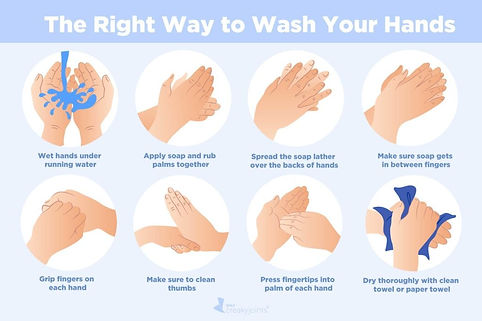What is hand hygiene?
Hand Hygiene means cleaning your hands by using either handwashing (washing hands with soap and water), antiseptic hand wash, antiseptic hand rub (i.e. alcohol-based hand sanitizer including foam or gel)
Why practice hand hygiene?
Cleaning your hands reduces:
-
The spread of potentially deadly germs to patients
-
The risk of healthcare provider infection caused by germs acquired from the patient
Methods of hand hygiene

-
Washing with soap and water
-
Hand sanitizer
-
Alcohol-based hand sanitizers are the most effective products for reducing the number of germs on the hands of healthcare providers.
-
Alcohol-based hand sanitizers are the preferred method for cleaning your hands in most clinical situations.
-
Wash your hands with soap and water whenever they are visibly dirty, before eating, and after using the restroom.
-
-
Wash your hands often with soap and water for at least 20 seconds especially after you have been in a public place, or after blowing your nose, coughing, or sneezing.
-
If soap and water are not readily available, use a hand sanitizer that contains at least 60% alcohol. Cover all surfaces of your hands and rub them together until they feel dry.
-
Avoid touching your eyes, nose, and mouth with unwashed hands.
Soap and Water
1- Rinse hands with water and add soap. Avoid hot water, as that can dry out hands.
2- Scrub briskly for at least 20 seconds, ensuring that you don’t miss any surface areas.
3- Rinse off the soap and dry hands with a disposable towel.
4- To turn off the water, avoid touching the faucet directly. Use a disposable towel instead.
Hand Sanitizer
For hand sanitizer, follow these guidelines:
-
Apply alcohol-based hand sanitizer to both hands.
-
Rub hands so that all surface areas get the product on them.
-
Keep rubbing until the sanitizer dries (about 20 seconds).
During Hours of Operation
Using an alcohol-based hand sanitizer:
-
Immediately before and after touching equipment or engaging with customers or co-workers
-
After coming in close contact with a customer or the customer’s immediate environment
-
Immediately after glove removal
-
Any situations that breaks social distancing guidelines
-
Before and after each shift and during breaks
Wash with soap and water:
-
When hands are visibly soiled
-
After known or suspected exposure to any customers or employees who are sick or not feeling well (potentially showing symptoms)
-
Before and after each shift and during breaks
-
Any transactions that involves cash or change
-
Before and after each cleaning procedures
Coughing & Sneezing
Covering coughs and sneezes and keeping hands clean can help prevent the spread of serious respiratory illnesses like influenza, respiratory syncytial virus (RSV), whooping cough, and COVID-19. Germs can be easily spread by:
-
Coughing, sneezing, or talking
-
Touching your face with unwashed hands after touching contaminated surfaces or objects
-
Touching surfaces or objects that may be frequently touched by other people
To Help Stop the Spread of COVID-19
-
Cover your mouth and nose with a tissue when you cough or sneeze
-
Throw used tissues in the trash
-
If you don’t have a tissue, cough or sneeze into your elbow, not your hands
-
Wash hands immediately after
Important Info To Remember
Remember to immediately wash your hands after blowing your nose, coughing or sneezing.
Washing your hands is one of the most effective ways to prevent yourself and your loved ones from getting sick, especially at key times when you are likely to get and spread germs.
-
Wash your hands with soap and water for at least 20 seconds
-
If soap and water are not readily available, use an alcohol-based hand sanitizer that contains at least 60% alcohol to clean hands
